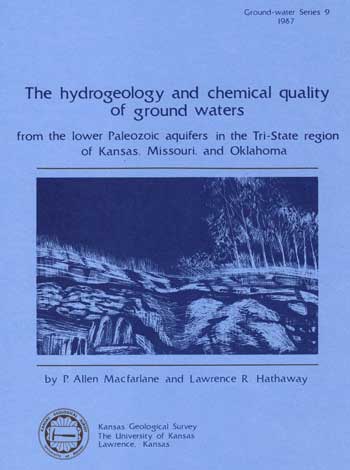The hydrogeology and chemical quality of ground waters from the lower Paleozoic aquifers in the Tri-State region of Kansas, Missouri, and Oklahoma
DOI:
https://doi.org/10.17161/kgsbulletin.no..23541Abstract
The lower Paleozoic aquifers (principally the Cambrian-Ordovician) are an important resource producing freshwater for municipal water supplies, industry, and agriculture in southeast Kansas, southwest Missouri, and northeast Oklahoma (the Tri-State region). These aquifers produce oil in Labette and Montgomery counties in Kansas. Aquifers in undifferentiated Mississippian and Cambrian-Ordovician carbonate rocks comprise the lower Paleozoic aquifer system. The Mississippian and Cambrian-Ordovician aquifers are generally separated by confining layers of shale and dense dolomite except in areas of southern Cherokee County, Kansas; northern Ottawa County, Oklahoma; and Jasper and Newton counties, Missouri. Both aquifer systems seem to be interconnected in these areas on the basis of the hydrogeochemistry and the hydraulic-head differences between the aquifers. The undifferentiated Mississippian is unconfined where the unit is at the surface in the southeastern part of the study area. Along the Kansas-Missouri state line, ground-water flow in both aquifers is generally westward except in the vicinity of municipal and industrial well fields where large-scale withdrawals of ground water may have changed the prevailing direction of ground-water flow. Very little hydrologic data are available for the Mississippian aquifer. Three ground-water regions can be broadly defined in the Cambrian-Ordovician aquifer reflecting the mixing of fresh and saline waters. From east to west, one encounters: 1) a freshwater portion containing Ca-HCO3-type ground waters; 2) a transition zone where the total dissolved solids and the contribution from NaCl-type waters increase rapidly in a westerly direction; and 3) a saline portion containing sodium chloride brines. The Mississippian outcrop is the approximate boundary of the freshwater transition zone. The 2,500 mg/L isochlor is taken as the boundary of the saline transition zone. Sulfide concentrations >0.2 mg/L are associated with ground waters west of the Mississippian outcrop. These three zones in the Cambrian-Ordovician aquifer evolved over geologic time as freshwater recharge entering the aquifer in the Ozark region of Missouri flushed saline waters from large portions of the study area. The distribution of radium-226, uranium, and uranium-234/uranium-238 activity ratios in waters from the Cambrian-Ordovician aquifer is consistent with a freshwater transition zone and saline hydrogeochemical partitioning of the aquifer. The manner in which these parameters change from the freshwater to transitional environments suggests that the source of radium-226 in the eastern part of the transition zone is largely from the radioactive decay of uranium precipitated on surfaces in the carbonate aquifer in the comparatively recent geologic past. The relative enrichment of radium-226 in waters from the saline portion of the aquifer system is problematic.

Downloads
Published
Issue
Section
License
Copyright (c) 2025 P. Allen Macfarlane , Lawrence R. Hathaway

This work is licensed under a Creative Commons Attribution-NonCommercial 4.0 International License.
